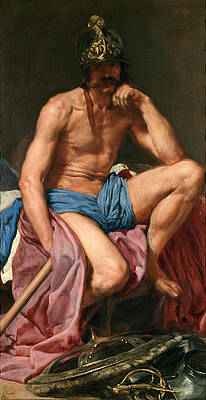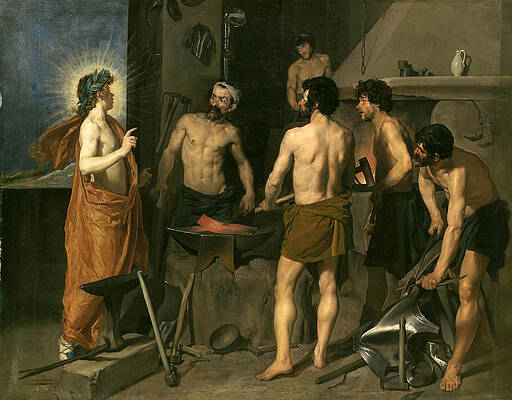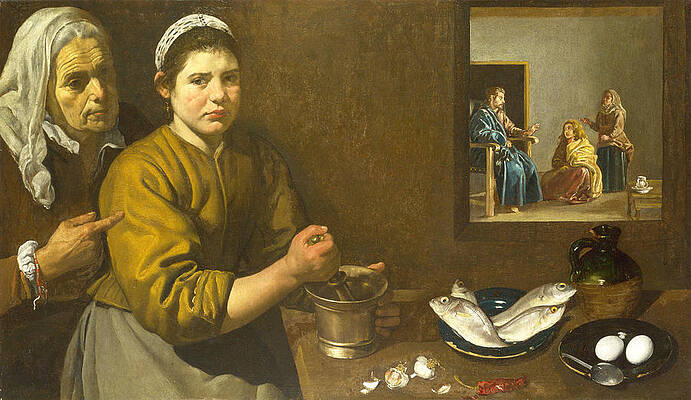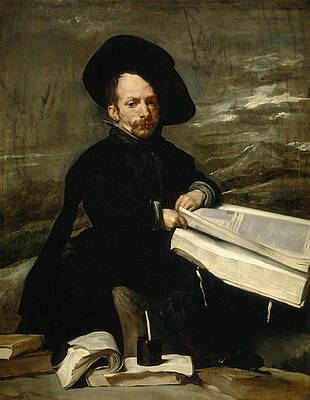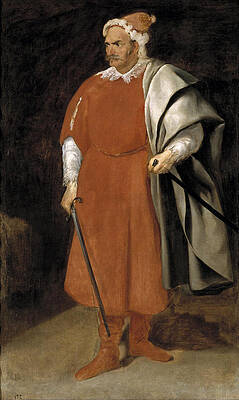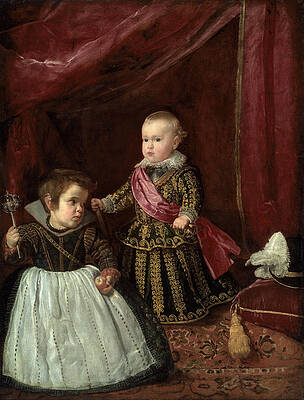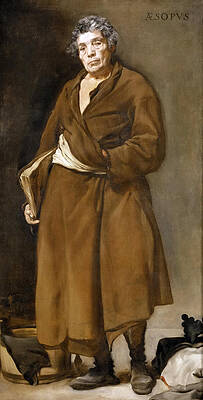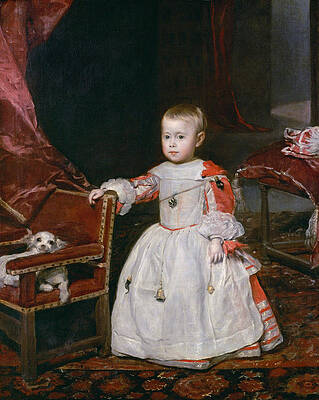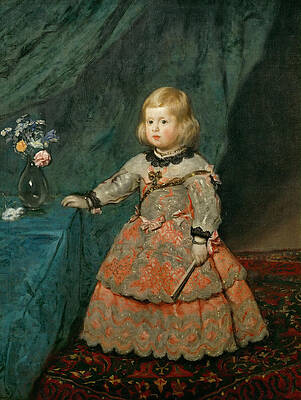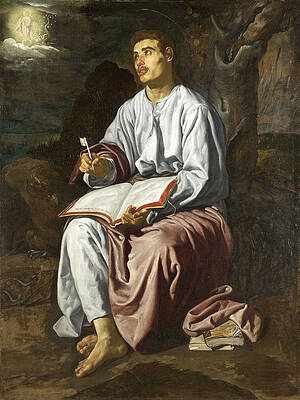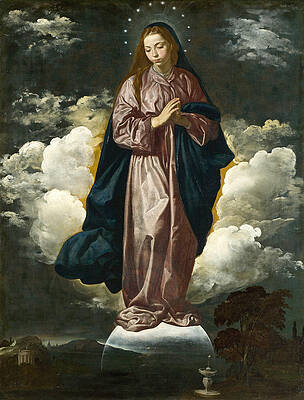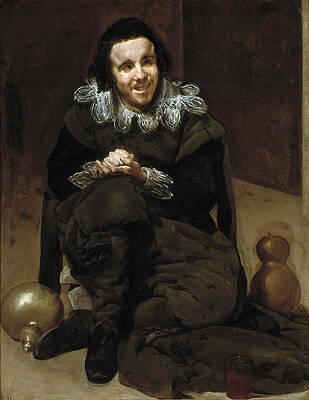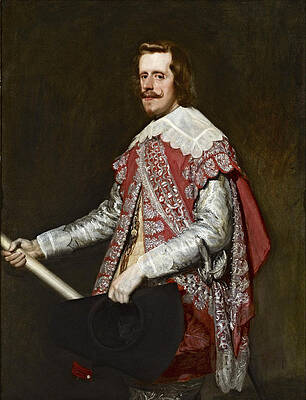Diego Velázquez
Paintings
Las Meninas. The Maids of Honour
Mars Resting
Infanta Margarita Teresa in a White dress
Head of an Apostle
The Rokeby Venus
An old woman frying eggs
The Spinners. Las Hilanderas
Apollo in the Forge of Vulcan
The Waterseller of Seville
Christ in the House of Martha and Mary
Portrait of the Infanta Maria Teresa
Portrait of Don Diego del Corral y Arellano
The Jester Don Diego de Acedo
Infanta Margarita Teresa in a Blue Dress
View of the Garden of the Villa Medici
The Gardens of the Villa Medici in Rome
Philip III on Horseback
Equestrian Portrait of Margarita of Austria
Portrait of Sebastian de Morra
The Jester Barbarroja
Don Baltasar Carlos with a Dwarf
The Needlewoman
Dona Antonia de Ipenarrieta y Galdos and Her Son Don Luis
Head of a Stag
Saint Rufina
Aesop
Christ on the Cross
Infante Philip Prosper
The Jester Named Don John of Austria
Portrait of Philip IV King of Spain
Portrait of the Infante Baltasar Carlos
The Infanta Margarita Teresa in a Pink Dress
Christ contemplated by the Christian Soul
Philip IV hunting Wild Boar
Philip IV of Spain in Brown and Silver
Portrait of Archbishop Fernando de Valdes
Philip IV of Spain
Saint John the Evangelist on the Island of Patmos
The Immaculate Conception
The Jester Calabacillas
Portrait of Francisco Lezcano
Portrait of Philip IV in Fraga
The Triumph of Bacchus
Maria Teresa Infanta of Spain
Kitchen Still Life
Saint Anthony Abbot
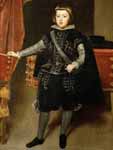
Portrait of the Infante Baltasar Carlos

Portrait of the Infanta Maria Teresa

Portrait of Philip IV King of Spain
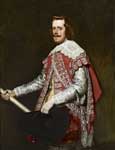
Portrait of Philip IV in Fraga
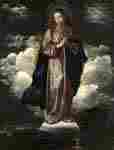
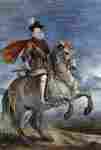
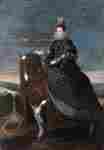
Equestrian Portrait of Margarita of Austria

Portrait of Don Diego de Corral y Arellano

Portrait of the court jester Don Juan de Austria




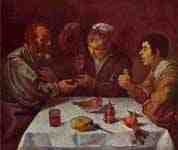
Farmers at the meal ( "El Almuerzo " )
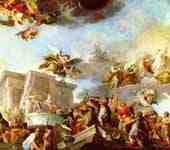
Christopher Columbus presents the New World
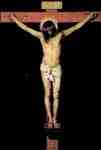

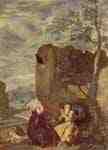
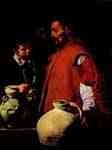
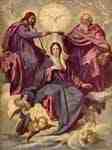
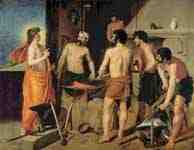
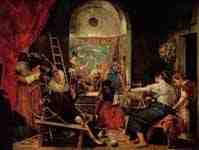
The Spinners ( The Fable of Arachne )
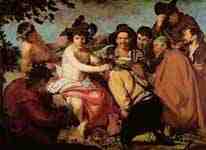
The Drinkers ( The Triumph of Bacchus )
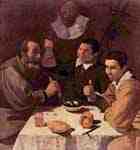
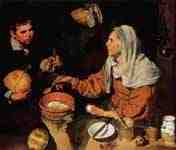
An old woman frying eggs ( The old cook )
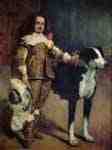
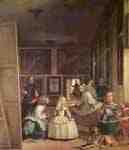

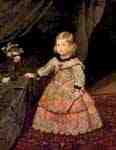
Portrait of the Infanta Margareta Teresa
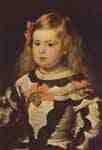
Portrait of the Infanta Margareta Teresa , detail
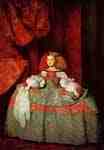
Portrait of the Infanta Margarita as a young girl
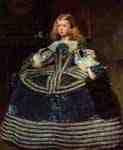
Infanta Margarita at the age of eight years
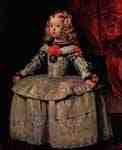
Infanta Margherita around the age of 3 years
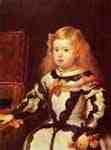
Infanta Maria Margarita, daughter of Philip IV
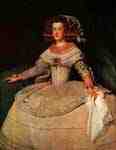
Infanta Maria Teresa at the age of 14 years

Portrait of the Infanta Maria of Austria

Portrait of Mariana de Austria

Portrait of mother Jerónima de la Fuente

Portrait of the poet Luis de Góngora y Argote


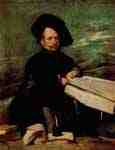
Portrait of the court jester ' El Primo "

Portrait of the court jester Barbarossa
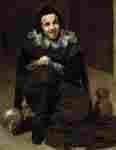
Portrait of the court jester Juan de Calabazas
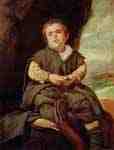
Portrait of Francisco Lezcano Court dwarf
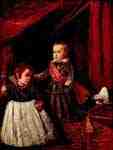
Infant Baltasar Carlos with a Dwarf

Portrait of the Infante Don Carlos

Portrait of the Infante Don Fernando de Austria
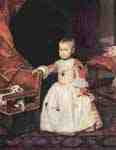
Portrait of the Infante Philip Prosper
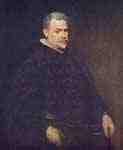
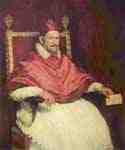



Portrait of Philip IV as a Hunter
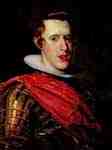
Portrait of Philip IV in Armor, fragment
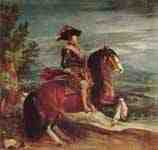
Portrait of Philip IV on horseback

Portrait of Prince Baltasar Carlos as a Hunter

Portrait of Prince Balthasar Carlos on horseback
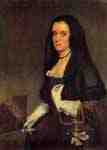
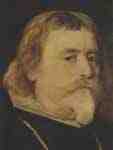
Portrait of an old gentleman , detail
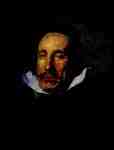
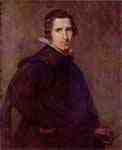

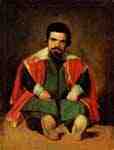
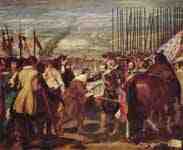
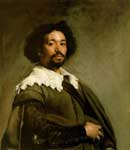

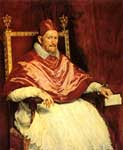
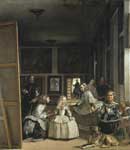
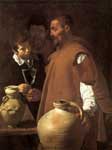
Drawings
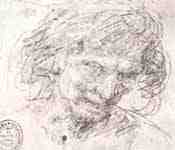
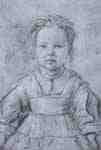
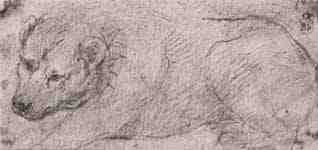

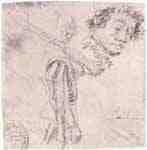
Diego Rodríguez de Silva y Velázquez (/vəˈlɑːskeɪs, -kəs/;[1] Spanish: [ˈdjeɣo roˈðɾiɣeθ de ˈsilba i βeˈlaθkeθ]; baptized on June 6, 1599 – August 6, 1660) was a Spanish painter who was the leading artist in the court of King Philip IV and one of the most important painters of the Spanish Golden Age. He was an individualistic artist of the contemporary Baroque period, important as a portrait artist. In addition to numerous renditions of scenes of historical and cultural significance, he painted scores of portraits of the Spanish royal family, other notable European figures, and commoners, culminating in the production of his masterpiece Las Meninas (1656).
From the first quarter of the nineteenth century, Velázquez's artwork was a model for the realist and impressionist painters, in particular Édouard Manet. Since that time, famous modern artists, including Pablo Picasso, Salvador Dalí and Francis Bacon, have paid tribute to Velázquez by recreating several of his most famous works.
Early life
Birthplace of Velázquez in Seville
Born in Seville, Andalucia, Spain, Diego, the first child of João Rodrigues da Silva and Jerónima Velázquez, was baptized at the church of St. Peter in Seville on Sunday, June 6, 1599. This christening must have followed the baby's birth by no more than a few weeks, or perhaps only a few days. Velázquez's paternal grandparents, Diego da Silva and Maria Rodrigues, Portuguese Jews,[2][3][4][5] had moved to Seville from their native Porto, Portugal decades earlier. As for João Rodrigues da Silva and his wife, both were born in Seville, and were married, also at the church of St. Peter, on December 28, 1597. They came from the lesser nobility and were accorded the privileges generally enjoyed by the gentry.
Velázquez was educated by his parents to fear God and, intended for a learned profession, received good training in languages and philosophy. Influenced by many artists he showed an early gift for art; consequently, he began to study under Francisco de Herrera, a vigorous painter who disregarded the Italian influence of the early Seville school. Velázquez remained with him for one year. It was probably from Herrera that he learned to use brushes with long bristles.
After leaving Herrera's studio when he was 12 years old, Velázquez began to serve as an apprentice under Francisco Pacheco, an artist and teacher in Seville. Though considered a generally dull, undistinguished painter, Pacheco sometimes expressed a simple, direct realism in contradiction to the style of Raphael that he was taught. Velázquez remained in Pacheco's school for five years, studying proportion and perspective and witnessing the trends in the literary and artistic circles of Seville.
To Madrid (early period)
Vieja friendo huevos (1618, English: Old Woman Frying Eggs). National Gallery of Scotland, Edinburgh.
By the early 1620s, his position and reputation were assured in Seville. On April 23, 1618, Velázquez married Juana Pacheco (June 1, 1602 – August 10, 1660), the daughter of his teacher. She bore him two daughters—his only known family. The elder, Francisca de Silva Velázquez y Pacheco (1619–1658), married painter Juan Bautista Martínez del Mazo at the Church of Santiago in Madrid on August 21, 1633; the younger, Ignacia de Silva Velázquez y Pacheco, born in 1621, died in infancy.[6]
Velázquez produced notable works during this time. Known for his compositions of amusing genre scenes (also called bodegones), such as Old Woman Frying Eggs, his sacred subjects include Adoración de los Reyes (1619, The Adoration of the Magi), and Jesús y los peregrinos de Emaús (1626, Christ and the Pilgrims of Emmaus), both of which begin to express his more pointed and careful realism.
Madrid and Philip IV
Velázquez went to Madrid in the first half of April 1622, with letters of introduction to Don Juan de Fonseca, himself from Seville, who was chaplain to the King. At the request of Pacheco, Velázquez painted the portrait of the famous poet Luis de Góngora. Velázquez painted Góngora crowned with a laurel wreath, but painted over it at some unknown later date. It is possible that Velázquez stopped in Toledo on his way from Seville, on the advice of Pacheco, or back from Madrid on that of Góngora, a great admirer of El Greco, having composed a poem on the occasion of his death.
In December 1622, Rodrigo de Villandrando, the king's favorite court painter, died. Don Juan de Fonseca conveyed to Velázquez the command to come to the court from the Count-Duke of Olivares, the powerful minister of Philip IV. He was offered 50 ducats (175 g of gold—worth about €2000 in 2005) to defray his expenses, and he was accompanied by his father-in-law. Fonseca lodged the young painter in his own home and sat for a portrait himself, which, when completed, was conveyed to the royal palace. A portrait of the king was commissioned. On August 16, 1623, Philip IV sat for Velázquez. Completed in one day, the portrait was likely to have been no more than a head sketch, but both the king and Olivares were pleased. Olivares commanded Velázquez to move to Madrid, promising that no other painter would ever paint Philip's portrait and all other portraits of the king would be withdrawn from circulation. In the following year, 1624, he received 300 ducats from the king to pay the cost of moving his family to Madrid, which became his home for the remainder of his life.
El Triunfo de Baco o Los Borrachos 1629 (English: The Triumph of Bacchus/The Drunks)
Portrait of the Infanta Maria Theresa, Philip IV's daughter with Elisabeth of France.
Through the bust portrait of the king, painted in 1623, Velázquez secured admission to the royal service, with a salary of 20 ducats per month, besides medical attendance, lodgings and payment for the pictures he might paint. The portrait was exhibited on the steps of San Felipe and was received with enthusiasm. It is now lost. The Museo del Prado, however, has two of Velázquez's portraits of the king (nos. 1070 and 1071) in which the severity of the Seville period has disappeared and the tones are more delicate. The modeling is firm, recalling that of Antonio Mor, the Dutch portrait painter of Philip II, who exercised a considerable influence on the Spanish school. In the same year, the Prince of Wales (afterwards Charles I) arrived at the court of Spain. Records indicate that he sat for Velázquez, but the picture is now lost. In September 1628, Peter Paul Rubens came to Madrid as an emissary from the Infanta Isabella, and Velázquez accompanied him to view the Titians at the Escorial. Rubens was then at the height of his powers. The seven months of the diplomatic mission showed Rubens' brilliance as painter and courtier. Rubens had a high opinion of Velázquez, but he had no significant influence on his painting. He reinforced Velázquez's desire to see Italy and the works of the great Italian masters.
In 1627, Philip set a competition for the best painters of Spain with the subject to be the expulsion of the Moors. Velázquez won. His picture was destroyed in a fire at the palace in 1734. Recorded descriptions of it say that it depicted Philip III pointing with his baton to a crowd of men and women being led away by soldiers, while the female personification of Spain sits in calm repose. Velázquez was appointed gentleman usher as reward. Later he also received a daily allowance of 12 réis, the same amount allotted to the court barbers, and 90 ducats a year for dress. Five years after he painted it in 1629, as an extra payment, he received 100 ducats for the picture of Bacchus (The Triumph of Bacchus). The spirit and aim of this work are better understood from its alternate Spanish name, Los Borrachos (The Drunks) or Los Bebedores (the drinkers), who are paying mock homage to a half-naked ivy-crowned young man seated on a wine barrel. The painting is firm and solid, and the light and shade are more deftly handled than in former works. Altogether, this production may be taken as the most advanced example of the first style of Velázquez.
Italian period
In 1629, he went to live in Italy for a year and a half. Though his first Italian visit is recognized as a crucial chapter in the development of Velázquez's style – and in the history of Spanish Royal Patronage, since Philip IV sponsored his trip – we know rather little about the details and specifics: what the painter saw, whom he met, how he was perceived and what innovations he hoped to introduce into his painting. It is canonical to divide the artistic career of Velázquez by his two visits to Italy, with his second grouping of works following the first visit and his third grouping following the second visit. This somewhat arbitrary division may be accepted though it will not always apply, because, as is usual in the case of many painters, his styles at times overlap each other. Velázquez rarely signed his pictures, and the royal archives give the dates of only his most important works. Internal evidence and history pertaining to his portraits supply the rest to a certain extent.
Return to Madrid (middle period)
Velázquez then painted the first of many portraits of the young prince and heir to the Spanish throne, Don Baltasar Carlos, looking dignified and lordly even in his childhood, in the dress of a field marshal on his prancing steed. The scene is in the riding school of the palace, the king and queen looking on from a balcony, while Olivares attends as master of the horse to the prince. Don Baltasar died in 1646 at the age of seventeen, so, judging by his age in the portrait, it must have been painted in about 1641.
La rendición de Breda (1634–1635, English: The Surrender of Breda) was inspired by Velázquez's first visit to Italy, in which he accompanied Ambrogio Spinola, who conquered the Dutch city of Breda a few years prior. This masterwork depicts a transfer of the key to the city from the Dutch to the Spanish army during the Siege of Breda. It is considered one of the best of Velázquez's paintings.
The powerful minister Olivares was the early and constant patron of the painter. His impassive, saturnine face is familiar to us from the many portraits painted by Velázquez. Two are notable; one is a full-length, stately and dignified, in which he wears the green cross of the order of Alcantara and holds a wand, the badge of his office as master of the horse, the other, a great equestrian portrait in which he is flatteringly represented as a field marshal during action. In these portraits, Velázquez has well repaid the debt of gratitude that he owed to his first patron, whom Velázquez stood by during Olivares's fall from power, thus exposing himself to the great risk of the anger of the jealous Philip. The king, however, showed no sign of malice towards his favorite painter.
The sculptor Juan Martínez Montañés modeled a statue on one of Velázquez's equestrian portraits of the king, painted in 1636, which was cast in bronze by the Florentine sculptor Pietro Tacca and which now stands in the Plaza de Oriente at Madrid.[7] The original of this portrait no longer exists, but several others do. Velázquez, in this and in all his portraits of the king, depicts Philip wearing the golilla, a stiff linen collar projecting at right angles from the neck. It was invented by the king, who was so proud of it that he celebrated it by a festival followed by a procession to the church to thank God for the blessing. Thus, the golilla was the height of fashion, and appeared in most of the male portraits of the period.
Velázquez was in constant and close attendance on Philip, accompanying him in his journeys to Aragon in 1642 and 1644, and was doubtless present with him when he entered Lerida as a conqueror. It was then that he painted a great equestrian portrait in which the king is represented as a great commander leading his troops—a role which Philip never played except in pageantry. All is full of animation except the stolid face of the king. It hangs as a pendant to the great Olivares portrait—fit rivals of the neighboring Charles V by Titian, which inspired Velázquez to excel himself, and both remarkable for their silvery tone and their feeling of open air.
Lady from court, c. 1635
Portraiture
Besides the forty portraits of Philip by Velázquez, he painted portraits of other members of the royal family: Philip's first wife, Elisabeth of Bourbon, and her children, especially her eldest son, Don Baltasar Carlos, of whom there is a beautiful full-length in a private room at Buckingham Palace. Cavaliers, soldiers, churchmen, and the poet Francisco de Quevedo (now at Apsley House), sat for Velázquez.
Portrait of Pablo de Valladolid, 1635, a court fool of Philip IV.
Velázquez also painted several buffoons and dwarfs in Philip's court, often with respect and sympathetically, as in The Favorite (1644), whose intelligent face and huge folio with ink-bottle and pen by his side show him to be a wiser and better-educated man than many of the gallants of the court. Pablo de Valladolid (1635), a buffoon evidently acting a part, and The Buffoon of Coria (1639) belong to this middle period.
The greatest of the religious paintings by Velázquez also belongs to this middle period, the Christ Crucified (1632). It is a work of tremendous originality, depicting Christ immediately after death. The Savior's head hangs on his breast and a mass of dark tangled hair conceals part of the face. The figure stands alone. The picture was lengthened to suit its place in an oratory, but this addition has since been removed. Some believe that the man in this painting is his uncle.
Velázquez's son-in-law Juan Bautista Martinez del Mazo had succeeded him as usher in 1634, and Mazo himself had received a steady promotion in the royal household. Mazo received a pension of 500 ducats in 1640, increased to 700 in 1648, for portraits painted and to be painted, and was appointed inspector of works in the palace in 1647.
Portrait of Pope Innocent X, 1650
Philip now entrusted Velázquez with carrying out a design on which he had long set his heart: the founding of an academy of art in Spain. Rich in pictures, Spain was weak in statuary, and Velázquez was commissioned once again to proceed to Italy to make purchases.
Second visit to Italy
When he set out in 1649, he was accompanied by his assistant Juan de Pareja who at this point in time was a slave and who had been trained in painting by Velázquez. Velázquez sailed from Málaga, landed at Genoa, and proceeded from Milan to Venice, buying paintings of Titian, Tintoretto and Veronese as he went. At Modena he was received with much favor by the duke, and here he painted the portrait of the duke at the Modena gallery and two portraits that now adorn the Dresden gallery, for these paintings came from the Modena sale of 1746.
Those works presage the advent of the painter's third and latest manner, a noble example of which is the great portrait of Pope Innocent X in the Doria Pamphilj Gallery in Rome, where Velázquez now proceeded. There he was received with marked favor by the Pope, who presented him with a medal and golden chain. Velázquez took a copy of the portrait—which Sir Joshua Reynolds thought was the finest picture in Rome—with him to Spain. Several copies of it exist in different galleries, some of them possibly studies for the original or replicas painted for Philip. Velázquez, in this work, had now reached the manera abreviada, a term coined by contemporary Spaniards for this bolder, sharper style. The portrait shows such ruthlessness in Innocent's expression that some in the Vatican feared that Velázquez would meet with the Pope's displeasure, but Innocent was well pleased with the work, hanging it in his official visitor's waiting room.
In 1650 in Rome Velázquez also painted a portrait of Juan de Pareja, now in the Metropolitan Museum of Art in New York City, USA. This portrait procured his election into the Academy of St. Luke. Purportedly Velázquez created this portrait as a warm-up of his skills before his portrait of the Pope. It captures in great detail Pareja's countenance and his somewhat worn and patched clothing with an economic use of brushwork. In November 1650, Juan de Pareja was freed by Velázquez. The legal document exists.[8]
During his time in Rome, Velázquez commissioned twelve bronze copies of the Medici lions by Matteo Bonucelli da Lucca for the Room of Mirrors at the Royal Alcazar of Madrid, now in the Royal Palace of Madrid and the Museo del Prado.[9][10]
Return to Spain and later career
King Philip wished that Velázquez return to Spain; accordingly, after a visit to Naples, where he saw his old friend Jose Ribera, he returned to Spain via Barcelona in 1651, taking with him many pictures and 300 pieces of statuary, which afterwards were arranged and catalogued for the king. Undraped sculpture was, however, abhorrent to the Spanish Church, and after Philip's death these works gradually disappeared. Elisabeth of France had died in 1644, and the king had married Mariana of Austria, whom Velázquez now painted in many attitudes. He was specially chosen by the king to fill the high office of aposentador mayor, which imposed on him the duty of looking after the quarters occupied by the court—a responsible function which was no sinecure and one which interfered with the exercise of his art. Yet far from indicating any decline, his works of this period are amongst the highest examples of his style.
Las Meninas
Las Meninas (1656).
Main article: Las Meninas
One of the infantas, Margaret Theresa, the eldest daughter of the new Queen, appears to be the subject of Las Meninas (1656, English: The Maids of Honour), Velázquez's magnum opus. However, in looking at the various viewpoints of the painting it is unclear as to who or what is the true subject. Is it the royal daughter, or perhaps the painter himself? The answer may lie in the image on the back wall, depicting the King and Queen. Is this image a mirror, in which case the King and Queen are standing where the spectator stands? Are they the subject of Velázquez's work? Or is the work simply a court painting?
Created four years before his death, it serves as an outstanding example of European baroque art. An apotheosis of the work has been effected since its creation; Luca Giordano, a contemporary Italian painter, referred to it as the "theology of painting", and in the eighteenth century the Englishman Thomas Lawrence cited it as the "philosophy of art", so decidedly capable of producing its desired effect. That effect has been variously interpreted; Dale Brown points out an interpretation that, in inserting within the work a faded portrait of the king and queen hanging on the back wall, Velázquez has ingeniously prognosticated the fall of the Spanish empire that was to gain momentum following his death. Another interpretation is that the portrait is in fact a mirror, and that the painting itself is in the perspective of the King and Queen, hence their reflection can be seen in the mirror on the back wall.
It is said the king painted the honorary Cross of Saint James of the Order of Santiago on the breast of the painter as it appears today on the canvas. However, Velázquez did not receive this honor of knighthood until three years after execution of this painting. Even the King of Spain could not make his favorite a belted knight without the consent of the commission established to inquire into the purity of his lineage. The aim of these inquiries would be to prevent the appointment to positions of anyone found to have even a taint of heresy in their lineage—that is, a trace of Jewish or Moorish blood or contamination by trade or commerce in either side of the family for many generations. The records of this commission have been found among the archives of the Order of Santiago. Velázquez was awarded the honor in 1659. His occupation as plebeian and tradesman was justified because, as painter to the king, he was evidently not involved in the practice of "selling" pictures.
In the 1966 book Les Mots et Les Choses (The Order of Things), philosopher Michel Foucault devotes the opening chapter to a detailed analysis of Las Meninas. He describes the ways in which the painting problematizes issues of representation through its use of mirrors, screens, and the subsequent oscillations that occur between the image's interior, surface, and exterior. In his book, The Dying Animal, Philip Roth uses Las Meninas as a metaphor for the distracted attraction of courtship.
Final years
Had it not been for this royal appointment, which enabled Velázquez to escape the censorship of the Inquisition, he would not have been able to release his La Venus del espejo (c. 1644–1648, English: Venus at her Mirror) also known as The Rokeby Venus. It is the only surviving female nude by Velázquez.
There were essentially only two patrons of art in Spain—the church and the art-loving king and court. Bartolomé Esteban Murillo was the artist favored by the church, while Velázquez was patronized by the crown. One difference, however, deserves to be noted. Murillo, who toiled for a rich and powerful church, left little means to pay for his burial, while Velázquez lived and died in the enjoyment of a good salary and pension.
One of his final works was Las hilanderas (The Spinners), painted circa 1657, representing either the interior of the royal tapestry works or a depiction of Ovid's Fable of Arachne, depending on interpretation. The tapestry in the background is based on Titian's The Rape of Europa, or, more probably, the copy that Rubens painted in Madrid.[11] It is full of light, air and movement, featuring vibrant colors and careful handling. Anton Raphael Mengs said this work seemed to have been painted not by the hand but by the pure force of will. It displays a concentration of all the art-knowledge Velázquez had gathered during his long artistic career of more than forty years. The scheme is simple—a confluence of varied and blended red, bluish-green, gray and black.
Portrait of the eight-year-old Infanta Margarita Teresa in a Blue Dress (1659).
Velázquez' final portraits of the royal children are among his finest works and in the Infanta Margarita Teresa in a Blue Dress[12] the painter's personal style reached its high-point here: shimmering spots of color on wide painting surfaces produce an almost impressionistic effect - the viewer must stand at a suitable distance to get the impression of complete, three-dimensional spatiality.
His only surviving portrait of the delicate and sickly Prince Felipe Prospero[13] is remarkable for its combination of the sweet features of the child prince and his dog with a subtle sense of gloom. The hope that was placed at that time in the sole heir to the Spanish crown is reflected in the depiction: fresh red and white stand in contrast to late autumnal, morbid colors. A small dog with wide eyes looks at the viewer as if questioningly, and the largely pale background hints at a gloomy fate: the little prince was barely four years old when he died. As in all of the artist's late paintings, the handling of the colors is extraordinarily fluid and vibrant.
In 1660 a peace treaty between France and Spain was consummated by the marriage of Maria Theresa with Louis XIV, and the ceremony took place on the Island of Pheasants, a small swampy island in the Bidassoa. Velázquez was charged with the decoration of the Spanish pavilion and with the entire scenic display. He attracted much attention from the nobility of his bearing and the splendor of his costume. On June 26 he returned to Madrid, and on July 31 he was stricken with fever. Feeling his end approaching, he signed his will, appointing as his sole executors his wife and his firm friend named Fuensalida, keeper of the royal records. He died on August 6, 1660. He was buried in the Fuensalida vault of the church of San Juan Bautista, and within eight days his wife Juana was buried beside him. Unfortunately, this church was destroyed by the French in 1811, so his place of interment is now unknown. There was much difficulty in adjusting the tangled accounts outstanding between Velázquez and the treasury, and it was not until 1666, after the death of King Philip, that they were finally settled.
In modernity
The importance of Velázquez's art even today is evident in considering the respect with which twentieth-century painters regard his work.
Until the nineteenth century, little was known outside of Spain of Velázquez's work. His paintings mostly escaped being stolen by the French marshals during the Peninsular War. In 1828 Sir David Wilkie wrote from Madrid that he felt himself in the presence of a new power in art as he looked at the works of Velázquez, and at the same time found a wonderful affinity between this artist and the British school of portrait painters, especially Henry Raeburn. He was struck by the modern impression pervading Velázquez's work in both landscape and portraiture. Presently, his technique and individuality have earned Velázquez a prominent position in the annals of European art, and he is often considered a father of the Spanish school of art. Although acquainted with all the Italian schools and a friend of the foremost painters of his day, he was strong enough to withstand external influences and work out for himself the development of his own nature and his own principles of art.
Velázquez is often cited as a key influence on the art of Édouard Manet, important when considering that Manet is often considered the bridge between realism and impressionism. Calling Velázquez the "painter of painters", Manet admired Velázquez's use of vivid brushwork in the midst of the Baroque academic style of his contemporaries and built upon Velázquez's motifs in his own art.
Modern recreations of classics
The importance of Velázquez's art even today is evident in considering the respect with which twentieth century painters regard his work. Pablo Picasso presented the most durable homages to Velázquez in 1957 when he recreated Las Meninas in 58 variations, in his characteristically cubist form. Although Picasso was concerned that his reinterpretations of Velázquez's painting would be seen merely as copies rather than unique representations, the enormous works-including the largest he had produced since Guernica in 1937, obtained a position of importance in the canon of Spanish art. Picasso retained the general form and positioning of the original in the context of its avant-garde cubist style.
Salvador Dalí, as with Picasso in anticipation of the tercentennial of Velázquez's death, created in 1958 a work entitled Velázquez Painting the Infanta Margarita With the Lights and Shadows of His Own Glory. The color scheme shows Dalí's serious tribute to Velázquez; the work also functioned, as in Picasso's case, as a vehicle for the presentation of newer theories in art and thought—nuclear mysticism, in Dalí's case.
The Anglo-Irish painter Francis Bacon found Velázquez's portrait of Pope Innocent X to be one of the greatest portraits ever made. He created several expressionist variations of this piece in the 1950s; however, Bacon's paintings presented a more gruesome image of the pope, who had now been dead for centuries. One such famous variation, entitled Figure with Meat (1954), shows the pope between two halves of a bisected cow.
Recent rediscoveries of Velázquez originals
In 2009, the Portrait of a Man in the collection of the Metropolitan Museum of Art, which had long been associated with the followers of Velázquez' style of painting, was cleaned and restored. It was found to be by Velázquez himself, and the features of the man match those of a figure in the painting "the Surrender of Breda". The newly cleaned canvas may therefore be a study for that painting. Although the attribution to Velázquez is regarded as certain, the identity of the sitter is still open to question. Some art historians regard this new study to be a self-portrait by Velázquez.[14]
In 2010 it was reported that a damaged painting long relegated to a basement of the Yale University Art Gallery might be an early work by Velázquez. Thought to have been given to Yale in 1925, the painting has previously been attributed to the 17th-century Spanish school. Some scholars are prepared to attribute the painting to Velázquez, though the Prado Museum in Madrid is reserving judgment. The work, which depicts the Virgin Mary being taught to read, will be restored by conservators at Yale.[15][16]
In October 2011 it was confirmed by art historian Dr. Peter Cherry of Trinity College Dublin through x-ray analysis that a portrait found in the UK in the former collection of the 19th-century painter Matthew Shepperson is a previously unknown work by Velázquez. The portrait is of an unidentified man in his fifties or sixties, who could possibly be Juan Mateos, the Master of the Hunt for Velázquez's patron, King Philip IV of Spain.[17] The painting measures 47 x 39 cm and was sold at auction on December 7, 2011 for £3,000,000.[18]
Descendants
Velázquez, through his daughter Francisca de Silva Velázquez y Pacheco (1619–1658), is an ancestor of the Marquesses of Monteleone, including Enriquetta (Henrietta) Casado de Monteleone (1725–1761) who in 1746 married Heinrich VI, Count Reuss zu Köstritz (1707–1783). Through them are descended a number of European royalty, among them Queen Sofía of Spain,[19] Queen Beatrix of the Netherlands, King Carl XVI Gustaf of Sweden, King Albert II of Belgium, Hans-Adam II, Prince of Liechtenstein, and Henri, Grand Duke of Luxembourg.[20]
400th anniversary of birth
Spain's celebration of the 400th anniversary of Velázquez's birth included major exhibitions of his work at the Prado Museum, as well as a renewed search for his tomb. International media covered the dig, which began April 30, 1999, at the Plaza de Ramales, one block from the Royal Palace, because that is where the medieval Church of San Juan stood until it was wrecked during the last century.[21] In early 2000, The Telegraph announced that the search for Velázquez's body would be abandoned: "A CAR park is to be built over what is widely believed to be the site of the tomb of Velázquez, one of Spain's greatest artists, after the authorities abandoned attempts to find his body...thought to have been buried in Madrid at the Iglesia de San Juan Bautista. For 18 months the authorities have been excavating the site of the church which is buried under a residential area. But now they have bowed to residents' demands for underground parking."[22]
Selected works
Main article: List of works by Diego Velázquez
Portrait of a Buffoon with a Dog, long attributed to Velázquez, but possibly by another painter.[23]
Velázquez was not prolific; he is estimated to have produced between only 110 and 120 known canvases.[24] Among these paintings, however, are many widely known and influential works.
Apollo in the Forge of Vulcan (Apolo en la Fragua de Vulcano) (1630) – Oil on canvas, 223 x 290 cm, Museo del Prado, Madrid
Christ in the House of Martha and Mary (1618) – Oil on canvas, 63 x 103.5 cm, National Gallery, London
Cristo crucificado (1631) – Oil on canvas, 248 x 169 cm, Museo del Prado, Madrid
Democritus (c. 1630) – Oil on canvas, 101 x 81 cm, Musée des Beaux-Arts, Rouen
El Triunfo de Baco (Los borrachos) (1628–1629) – Oil on canvas, 165 x 225 cm, Museo del Prado, Madrid
Temptation of St. Thomas (1632) – Oil on canvas, 244 x 203 cm, Museum of Orihuela Cathedral, Spain
Equestrian portrait of Duke de Olivares (1634) – Oil on canvas, 313 x 239 cm, Museo del Prado, Madrid
Esopo (1639–1640) – Oil on canvas, 179 × 94 cm, Museo del Prado, Madrid
Imposición de la casulla a San Ildefonso (1623) – Oil on canvas, 165 × 115 cm, Museo de Bellas Artes, Seville
Old Woman Frying Eggs (c. 1618) – Oil on canvas, 105 × 119 cm, National Gallery, Edinburgh
La reina Isabel de Borbón a caballo (1629) – Oil on canvas, 301 x 314 cm, Museo del Prado, Madrid
Las Hilanderas (The Fable of Arachne) (c. 1657) -Oil on canvas, 167 × 252 cm, Museo del Prado, Madrid
Las Meninas (1656) - Oil on canvas, 318 × 276 cm
Mars Resting (1640) - Oil on canvas, 179 × 95 cm, Museo del Prado, Madrid
Menipo (1639–1640) – Oil on canvas, 179 × 94 cm, Museo del Prado, Madrid
Mercury and Argus (1659) – Oil on canvas, 127 × 248 cm, Museo del Prado, Madrid
Portrait of Count Duke of Olivares (1624) – Oil on canvas, 202 x 107 cm, São Paulo Museum of Art, São Paulo
Portrait of Duke de Olivares (1635) - Oil on canvas, 67 × 54.5 cm, Hermitage Museum, St. Petersburg
Portrait of Innocent X (c. 1650) - Oil on canvas, 141 x 119 cm, Galleria Doria Pamphilj, Rome
Portrait of Juan de Pareja (1650) - Oil on canvas, 81.3 x 69.9 cm, Metropolitan Museum of Art, New York City
Infanta Margarita Teresa in a Pink Dress (c. 1653/1654) - Oil on canvas, 128 x 99,5 cm, Kunsthistorisches Museum, Vienna[25]
Infanta Margarita Teresa in a Blue Dress (1659) - Oil on canvas, 127 x 107 cm, Kunsthistorisches Museum, Vienna[12]
Infant Philipp Prosper (1659) - Oil on canvas, 129 x 99 cm, Kunsthistorisches Museum, Vienna[13]
Portrait of Mother Jerónima de la Fuente (1620) – Oil on canvas, 79 x 51 cm, Museo del Prado, Madrid[26][27][28]
Rokeby Venus (La Venus del espejo, c. 1648–1651) – Oil on canvas, 122 × 177 cm, National Gallery, London
The Surrender of Breda (1633–1635) – Oil on canvas, 307 × 367 cm, Museo del Prado, Madrid
The Adoration of the Magi (1619) – Oil on canvas, 203 × 125 cm, Museo del Prado, Madrid
The Lady with a Fan, (c. 1638–1639) – Oil on wood, 69 x 51 cm, The Wallace Collection, London[26][27][29][30]
The Lunch (c. 1617) – Oil on canvas, 108 x 102 cm, Hermitage Museum, St. Petersburg
The Waterseller of Seville (c. 1620) – Oil on canvas, 105 × 80 cm, Apsley House, London
San Pablo (c.1618) – Oil on canvas, 99 x 78 cm, Museu Nacional d'Art de Catalunya, Barcelona
Notes
"Velázquez". Random House Webster's Unabridged Dictionary.
JSTOR, The Jewish Ancestry of Velázquez
http://books.google.com/ e
Otaka, Yasujiro (September 2000). "An Aspiration Sealed". Special Issue: Art History and the Jew. Studies in Western Art. Retrieved 2007-12-08.
Diego Rodriguez de Silva y Velazquez Biography at diegovelazquez.org
"Juana and Diego Velazquez Marriage Profile". Marriage.about.com. Retrieved December 22, 2010.
"Juan Martínez Montañés". Catholic Encyclopedia. New York: Robert Appleton Company. 1913.
The manumission document was discovered by Jennifer Montagu. See Burlington Magazine, volume 125,1983,pages 683-4.
[1]
[2]
Bird, Wendy. "The Bobbin and the Distaff", Apollo, 2007-11-01. Retrieved on May 28, 2009.
Kunsthistorisches Museum, Wien "Infantin Margarita Teresa (1651-1673) in blauem Kleid | Diego Rodríguez de Silva y Velázquez | 1659 | Inv. No.: GG_2130" Retrieved on January 27, 2014.
Kunsthistorisches Museum, Wien "Infant Philipp Prosper (1657-1661) | Diego Rodríguez de Silva y Velázquez | 1659 | Inv. No.: GG_319" Retrieved on January 27, 2014.
[3]
Giles Tremlett in Madrid (July 1, 2010). "Yale basement yields Spanish treasure – a possible Velázquez masterpiece". The Guardian (UK). Retrieved December 22, 2010.
"Yale uncovers Velazquez in basement storage". CBC News. July 3, 2010. Retrieved December 22, 2010.[dead link]
Louise Jury (27 October 2011). "Portrait in hoard sent to auction revealed to be £3million Velázquez". London Evening Standard. Retrieved October 27, 2011.
"Rediscovered Velazquez painting sold for £3m at auction". BBC News. 7 December 2011. Retrieved September 29, 2012.
"Relationship between Queen Sofia of Spain and Velazquez". Europeandynasties.com. Retrieved December 22, 2010.
http://worldroots.com/brigitte/famous/v/velasquez.htm
Goodman, Al (September 7, 1999). "ARTS ABROAD; A Furor for Velazquez: His Art but Also His Bones". The New York Times.
Wilkinson, Isambard (December 7, 2000). "Spanish to put car park over Velazquez". The Daily Telegraph (London).
On-line gallery Prado Museum. Retrieved 31 October 2013.
Vogel, Carol (September 10, 2009). "An Old Spanish Master Emerges From Grime". The New York Times. Retrieved September 11, 2009. "Jonathan Brown, this country's leading Velázquez expert ... "Velázquez was a painter who measured out his genius in thimblefuls." His output was so small that, depending on who's counting, Mr. Brown estimates, there are only 110 to 120 known canvases by the artist."
Kunsthistorisches Museum, Wien "Infantin Margarita Teresa (1651-1673) in rosafarbenem Kleid | Diego Rodríguez de Silva y Velázquez | um 1653/1654 | Inv. No.: GG_321" Retrieved on January 27, 2014.
Serrano, Hanna, Tanya J. Tiffany and Ronald E. McNair. Mother Jeronima de la Fuente: Founder of First Convent of Nuns in the Philippines, A Woman Religious and Reflection of Christ, University of Wisconsin, Milwaukee, retrieved on June 17, 2007
Zirpolo, Lillian. Madre Jeronima de la Fuente and Lady With A Fan Two Portraits by Velazquez Reexamined Woman's Art Journal, Vol. 15, No. 1 (Spring – Summer, 1994), pp. 16–21, JStor.org, Retrieved on June 24, 2007
Great Masters Gallery, Diego Rodriguez de Silva Velazquez Art Reproductions, Jeronima de la Asuncion c.1620, 79 x 51 cm, The Wallace Collection, London, UK, 2007, retrieved on June 24, 2007
Great Masters Gallery, Diego Rodriguez de Silva Velazquez Art Reproductions, The Lady with a Fan, c.1630/50, The Wallace Collection, London, UK, 2007, retrieved on June 24, 2007
"Signs of identity in Lady with a Fan by Diego Velazquez: costume and likeness reconsidered". The Art Bulletin. March 2004. Archived from the original on October 16, 2007. Retrieved December 8, 2007. |first1= missing |last1= in Authors list (help)
Bibliography
Brown, Dale (1969). The World of Velázquez: 1599–1660. New York: Time-Life Books. ISBN 0-8094-0252-1.
Brown, Johnathan (1986) Velázquez: Painter and Courtier Yale University Press, New Haven, ISBN 0-300-03466-0 ;
Brown, Jonathan (1978) Images and Ideas in Seventeenth-Century Spanish Painting Princeton University Press, Princeton, New Jersey, ISBN 0-691-03941-0;
Brown, Johnathan (2008) Collected writings on Velázquez, CEEH & Yale University Press, New Haven, ISBN 978-0-300-14493-2.
Calvo Serraller, Francisco (1999). Velázquez:. Madrid: Electa. ISBN 84-8156-203-3.
Davies, David and Enriqueta Harris (1996) Velázquez in Seville National Gallery of Scotland, Edinburgh, ISBN 0-300-06949-9;
Public Domain White, John Forbes; Konody, Paul George (1911). "Velazquez, Diego Rodriguez de Silva y". In Chisholm, Hugh. Encyclopædia Britannica 27 (11th ed.). Cambridge University Press. pp. 974–978.
Domínguez Ortiz, A., Gállego, J., & Pérez Sánchez, A.E. (1989). Velázquez . New York: The Metropolitan Museum of Art. ISBN 9780810939066.
Elizabeth McGrath and Jean Michel Massing The Slave in European Art The Warburg Institute 2012.
"Enriqueta Harris resalta la 'pasión británica' por Velázquez en un simposio en Sevilla" (PDF). El Pais Digital. Archived from the original on October 24, 2004. Retrieved April 9, 2005.
Erenkrantz, Justin R. "The Variations on Past Masters". The Mask and the Mirror. Accessed on April 10, 2005.
Goldberg, Edward L. "Velázquez in Italy: Painters, Spies and Low Spaniards". The Art Bulletin, Vol. 74, No. 3 (Sep., 1992), pp. 453–456.
Prater, Andreas (2007) Venus ante el espejo, CEEH, ISBN 978-84-936060-0-8.
"Velázquez, Diego" (1995). Enciclopedia Hispánica. Barcelona: Encyclopædia Britannica Publishers. ISBN 1-56409-007-8.
Wolf, Norbert (1998) Diego Velázquez, 1599–1660: the face of Spain Taschen, Köln, ISBN 3-8228-6511-7;
Moser, Wolf (2011) Diego de Silva Velázquez: Das Werk und der Maler 2 Vols. Edition Saint-Georges, Lyon, ISBN 978-3-00-032155-9
Salort-Pons, Salvador, "Velázquez en Italia", Fundación de Apoyo a la História del Arte Hispanico, Madrid 2002,ISBN 84-932891-1-6
---
Fine Art Prints | Greeting Cards | Phone Cases | Lifestyle | Face Masks | Men's , Women' Apparel | Home Decor | jigsaw puzzles | Notebooks | Tapestries | ...
---
Artist
A - B - C - D - E - F - G - H - I - J - K - L - M -
N - O - P - Q - R - S - T - U - V - W - X - Y - Z
Retrieved from "http://en.wikipedia.org/"
All text is available under the terms of the GNU Free Documentation License



